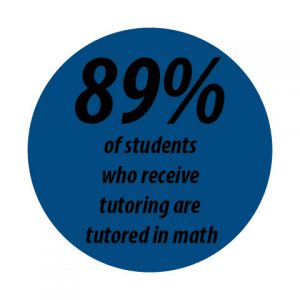Data from a recent Bark survey shows that many students are seeking out additional academic support outside the classroom from tutors and, in doing so, bypassing the options that are available to them here at school.
Nearly 50 percent of students surveyed acknowledged that they have utilized tutors during their time at Redwood, but not one of the 160 students surveyed has used the Peer Tutoring resource provided on campus. Virtually all of those who decided that tutoring support was necessary opted for private tutors off campus.
Assistant Principal LaSandra White is well aware that students tend to jump to private tutoring without first considering the school’s options, such as Peer Tutoring, or just taking more advantage of the office hours provided by teachers.

“Overall, I would say that the options we do have are probably underutilized,” she said. “I wouldn’t say that [private tutors] are unnecessary, but I think people need to better use what we offer here.”
Longtime science teacher Skip Lovelady, who has supervised Peer Tutoring for the past five years, said that he has some 30 to 40 peer tutors available for students, separated into shifts after school Monday through Wednesday each week. Given the modest number of students who take advantage of this resource, the ratio of tutor to student is often two-to-one or even as low as one-to-one.
White believes that students should exhaust the options that the school offers before going straight to private, off-campus help.
“I would just like to see a push to utilize what we actually have more, before we say there’s not enough,” she said.
Lovelady said that although a substantial number of students are turning to private tutors, he believes teachers provide an adequate amount of help and the school is not falling short in its ability to help students.
“If [teachers were at fault], then even Peer Tutoring would be overflowing, and we’re not. And we’re free,” Lovelady said. “I don’t think the reaching out for tutors … is a reflection of the school.”
Math teacher Julie Norwood said that students seeking outside help does not bother her, but she hopes students take advantage of help from their teachers first.
“It’s hard for me because I’m available about seven hours a week [outside of class], and a lot of the kids who claim that they spend all this money on tutors never come in to my help sessions,” she said.
Norwood and White both emphasized the importance of using one’s teacher as the primary source for assistance before seeking answers from outside help.
“As a teacher, I would obviously prefer that my kids come get help from me and that they feel comfortable. I give up that time just for that purpose,” Norwood said. “The highest quality [tutor] is going to be your teacher.”
Though Norwood would rather see her students approach her before their private tutors, she understands that some students prefer to have such a tutor for various reasons.
Lovelady believes that the amount of students who hire private tutors is directly correlated to the wealth of the Redwood community.

“I think the number of students who do [have a private tutor] at Redwood is solely based on their ability to pay for the tutor,” he said.
At a school with a lower socioeconomic status, Lovelady said, you would likely find that the number of students who wanted to hire a tutor would be comparable, while the number of students who could afford to have a private one would be significantly lower.
One might assume the quality of a paid, private tutor is much better than that of a peer, but Lovelady said there are some things a peer can offer that a private tutor cannot match.
“The peer on peer relationship is very powerful. I think I do a good job with my students one-on-one if they come to me for help, but I see as good—or better—help being given when it’s peer to peer,” Lovelady said.
However, Lovelady acknowledged the fact that a private tutor is paid to be knowledgeable and an expert about the subject.
“A quality adult tutor is simply going to have more background in the subject area than any kid who just took the class last year,” he said.
Despite the fact that most, if not all, teachers make themselves available throughout the school day during the week, they are not contractually obligated to provide “office hours” or any such assistance to students at any time outside of class. According to White, teachers are only required to be at school 15 minutes before and after the school day, and any meetings between teachers, students, and parents come out of teachers’ own time.
However, White has observed that teachers make enough time for students out of their own free will.
“I don’t think there’s ever a situation where a kid needs help with something, and the teacher can’t find the time to help them,” she said.






